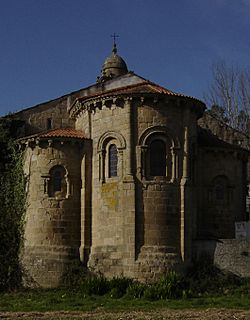Monastery of Xuvia facts for kids

Viewed from the south
|
|
| Monastery information | |
|---|---|
| Other names | Mosteiro do Couto |
| Order | Benedictine |
| Established | 6th-century - 10th century |
| Diocese | Mondoñedo |
| Site | |
| Location | Coruña, Galicia, Spain |
| Coordinates | 43°32′47.55″N 8°08′53.42″W / 43.5465417°N 8.1481722°W |
The Monastery of Xuvia, also known as San Martiño de Xuvia or San Martín de Xubia, is a very old building. It is located in the area of Xuvia, which is part of the city of Narón in Galicia, Spain. The building you see today was mostly built around the early 1100s. It was made in a style called Romanesque, which was popular for churches and monasteries back then.
Contents
What is San Martiño de Xuvia?
The San Martiño de Xuvia Monastery is a historic religious building. It served as a home for monks from the Benedictine order. Monasteries like this were important centers for learning and community life in the past. They often had large libraries and helped people in the local area.
A Look at Its History
This monastery has a very long history. The first written record we have about it dates back to May 15, 977. This document is part of the monastery's "Diplomatic Collection," which is a fancy name for its collection of important papers and official records.
In this old document, a noblewoman from Galicia named Visclavara Vistrariz gave a gift to the monastery. The document also mentions that the monastery was "ever known," meaning it was already famous and well-established even back in the year 977. This shows that the monastery existed long before the 12th-century building was constructed. It likely started much earlier, perhaps between the 6th and 10th centuries.
Romanesque Style Explained
The current monastery building is a great example of Romanesque architecture. This style was common in Europe from about the 10th to the 12th centuries. Romanesque buildings often have thick walls, round arches, sturdy pillars, and small windows. They were built to be strong and grand, often looking a bit like castles. The San Martiño de Xuvia Monastery shows these features, giving us a peek into how buildings looked nearly a thousand years ago.
Where is it Located?
The monastery is found in the province of A Coruña, within the region of Galicia in Spain. Galicia is in the northwest part of Spain, known for its green landscapes and rich history. The monastery is specifically in the parish of Xuvia, which is part of the city of Narón.
See also
 In Spanish: Monasterio de San Martín de Jubia para niños
In Spanish: Monasterio de San Martín de Jubia para niños

